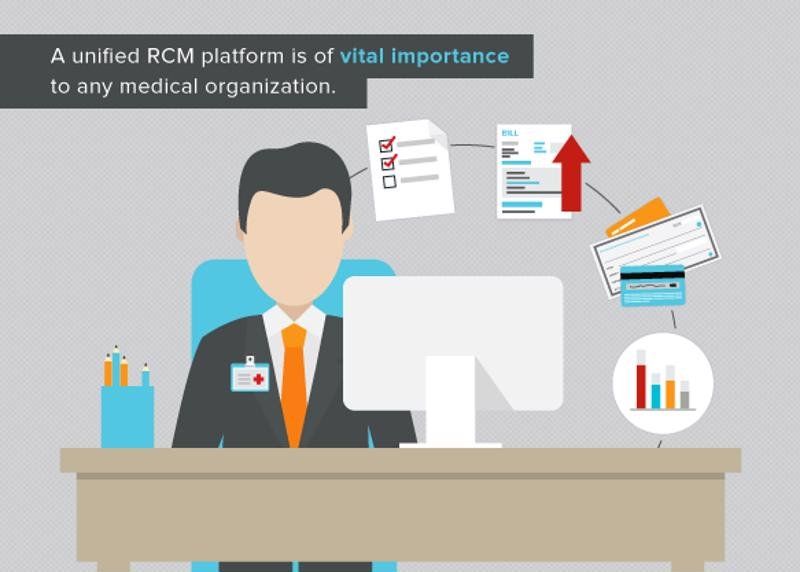Unify front- and back-end RCM to improve efficiency – and ROI
June 4, 2018
A unified RCM platform is of vital importance to any medical organization.
There's no denying the immense value and importance of the worldwide healthcare revenue cycle management market.
According to a report by Data Bridge Market Research, this segment should account for about $137 billion in revenue for healthcare providers by 2024.
Services-based RCM makes up the bulk of this field and will account for $50.9 billion in earnings for these industry entities by 2024.
The reason for this, of course, is the preponderance of issues that can present themselves within the context of any hospital, clinic or other major healthcare organization – particularly when operations have become improperly siloed and disconnected.
"Problems can arise out of any siloing that separates front- and back-end operations in medical organizations."
The key to eliminating such siloes lies with uniting RCM functions across both front- and back-end systems. Doing so can help administrators within these facilities bring a greater sense of efficiency and efficacy to all operations within the healthcare revenue cycle.
Even better, unifying these operations can ultimately provide better experiences for both hospital staff and patients alike.
Isolation, knowledge gaps caused by separated operations
On the surface, one can perhaps understand why front- and back-end hospital operations would be distinctly separated from each other, even solely within the RCM sphere.
In the former segment, admissions, insurance coverage confirmation and other basic but essential information-gathering tasks take place.
Meanwhile, the back end involves things that can be considerably more complex: medical billing on macro and micro scales, claims and denials management, and various other necessary financial interactions between healthcare organizations and patients or payers.
The primary problem with keeping these two halves of RCM separate is the misunderstanding that the front end may have about the back end, and vice versa.
As pointed out by RevCycleIntelligence, front-end staff in siloed situations won't necessarily know as much about claims processing. At the same time, those working in the back-end trenches can lose touch with the patient-facing tasks that require a measure of empathy and understanding for different patients' needs.
Bringing them together, by contrast, can help all pockets of organizational staff expand their horizons and knowledge.

Combining front- and back-end RCM leads to both greater ROI and more efficient organizational processes.
Unification to improve efficiency
Rebecca Wright, vice president of strategic planning at Iroquois Memorial Hospital in Watseka, Illinois, commented further on the problem of siloing and the advantages of bringing front- and back-end operations together, in an interview with RevCycleIntelligence.
"In the past, it's always been focused on back-end or business office in collections, and we turned it on [its] head and looked at how we can push it more to the front end," Wright said. "Because we knew by pushing more of it to the front end, we could reduce overall costs for our organization and make outcomes a little bit better."
In the case of Wright's hospital, administrators moved all back-end operations to the front. This gambit succeeded and allowed for greater understanding of not only individual accounts, but also the overall revenue cycle and how everything connects.
Leveraging data essential to success
Easy access to all pertinent patient and claims information serves as the catalyst to all successful healthcare RCM operations – specifically, the control of that data to glean the seeds of actionable strategies.
There are numerous ways to capture and eventually utilize this data, and the specific choice of platform and methodology will vary between healthcare organizations.
According to Becker's Hospital Review, blockchain has emerged as a common technique for streamlining RCM, due mainly to its potential for predictive action. But implementing a new technology like blockchain may not be the right call for every healthcare provider.
What's most important is the ability to acquire all essential patient information – personal, financial and everything in between – at registration. Additionally, adopting a solution in which patient information can easily be matched with data from that individual's employer can provide further organization and efficacy to the process.

In 2016, healthcare vendors need the most efficient claims processing systems out there. By now, flexible, web-focused methods for important claims tasks are clearly the industry's path forward, and will play a major role in bridging the gap between patients and providers. A fast, digital claims method makes a direct link from implementation to delivery for workers' compensation and motor vehicle billing alike. Now is the time to invest in better revenue cycle management, with a focus on detail-driven, well-facilitated collection that breaks down barriers. Despite the growing pains involved with adopting any new technology, there are a couple of areas where smarter systems have already improved claims processing online. Direct accessibility With each new convenience, the future of healthcare looks more integrated. Data analytics harvests insights from seemingly unrelated details for fuller results. To make this innovation worthwhile, however, there needs to be a distinct pipeline between entities. "Data analytics harvests insight from seemingly unrelated details." Online healthcare portals are already addressing this need, providing direct communication through smart devices like phones and tablets. By bringing necessary information together in a simple, accessible source, these solutions set the stage for clean claims assembly. Shorter cycles Proper collection from the outset can reduce the amount of work hospitals have to do later if the claim is resubmitted, according to Gary Marlow, Vice President of Finance at Beverly Hospital and Addison Gilbert Hospital. "From a revenue cycle perspective, getting the most accurate information up front starts with patient scheduling and patient registration," Marlow told RevCycleIntelligence in 2015. "That provides the groundwork by which claims can be billed and collected in the most efficient and effective manner possible." The way information enters the claims process can impact how it gets managed. If technology, like artificial intelligence, is present at the beginning and guides the claims throughout, there's a consistent system handling the information the process to meet best practices. PROMEDICAL's benefits With our secure, efficient and comprehensive system, PROMEDICAL is staying ahead of the game. We're doing that by developing the following features: Communication: Users can choose from multiple languages with our online offerings. This allows you to customize your system to better reach patient populations and keep claims moving faster. Customization: If our proprietary options aren't currently meeting your needs, we can change them to do so based on feedback. Adapt to state fee schedules or language demands on a case by case basis. Encryption: A must for secure file exchange, PROMEDICAL ensures a secure file transfer process. Our process protects backup data equally strong as primary data, for efficient security across the board. Planning: Organizations also benefit when a set deadline is involved, putting clear limits on when submissions are set for review. Processing records requests within a preordained period of days helps managers know what to expect, and regular reports set up clear overviews of important statistics. Contact PROMEDICAL today to learn more about our healthcare revenue cycle solutions.

According to Pew Research, 15 percent of U.S. adults have used ridesharing services . Where does insurance enter the picture? Uber, Lyft and other ridesharing apps throw a proverbial wrench in hospitals' revenue cycle management operations. Billing is already a major pain point in hospitals – Black Book Research noted most facilities are outsourcing their RCM because in-house teams lack the resources to efficiently handle motor vehicle reimbursement. Ridesharing will only exacerbate the issue. For example, if a rider gets injured and has to go to the hospital, from which institution does the hospital receive reimbursement : The driver's insurance? The passenger's? Uber's? As Uber and Lyft are the most popular ridesharing apps, we'll focus on how these companies handle driver insurance. How do Lyft and Uber insure drivers? Lyft has three types of coverage within its insurance policies: Contingent Liability activates when a driver logs into the app and requests to accept rides – a state Lyft designates as "Driver mode." This coverage provides up to $100,000 per accident for bodily injury. Contingent Comprehensive and Collision kicks in when a driver has picked up a passenger. This coverage applies when a non-collision event damages the driver's vehicle. Uninsured/Underinsured Motorist applies when an at-fault driver who is uninsured or underinsured causes bodily injury to himself, his passengers or any third parties. The coverage provides $1 million per incident, and includes no deductible. For example, if a driver is injured in an accident at a time when he is not working for Lyft, his personal insurance will cover him (assuming he lives in a no-fault state, but that's another issue). However, when the driver activates Driver mode, Lyft's Contingent Liability will protect him even if he hasn't accepted a ride from a passenger. What if the driver's at fault? According to Rideshare Dashboard, Lyft's commercial insurance will cover all damages to third parties and the passenger, but the driver will have to cover his own medical expenses. That's when state laws dictate payment. In Massachusetts, for example, which also happens to be a no-fault state and requires all motor vehicle owners to possess auto insurance, the rider's personal auto insurance will cover the medical bills. Uber's insurance system is somewhat similar to Lyft's but possesses a few minor differences. For example, when an Uber driver is transporting a passenger, and another motorist causes an accident that results in bodily injury to the driver, the passenger and anyone else involved, Uber's UM/UMI will cover bodily injury of anyone in the rideshare vehicle.

With new, transformative technological advancements on the rise, it's no surprise that nearly every industry is feeling the impact of the digital age. From a healthcare provider's perspective, new resources can be used to revamp the current revenue cycle management processes you have in place. To reap the benefits of an optimized approach, you must be willing to take advantage of such emerging technological tools and resources, as stated by Chad Sandefur, Director and Healthcare Analyst at AArete. "Generally speaking, in order to strengthen the revenue cycle management, embracing technology within the revenue cycle is key," Sandefur shared with RevCycleIntelligence.com. "Having the platforms to seamlessly facilitate provider-payer interactions are really integral. In many cases, it's mostly about bad debt avoidance. With that in mind, there are a few specific points." Let's take a closer look at the benefits of utilizing technology, plus some of the emerging resources your facility can use to revamp your current RCM processes: The benefits of an optimized approach By paying attention to the new digital advancements that can benefit your RCM, you can ultimately impact the workflow of your staff members while better streamlining services for consumers. Here are some of the advantages of an optimized approach: Reduced chance for human error – Human error is inevitable when handling large amounts of data. Management software can be used to keep track of patient data input and maintenance. Better opportunity for precise, automated data entry – Between appointment scheduling, data input and claims submission, employees have a lot of duties. Automated software can take care of some of these responsibilities, allowing staff members to better focus on a single task at a time. I ncreased cash flow – Claims management technology can expedite claims quickly and produce clean, accurate claims, ultimately increasing cash flow , as stated by Becker's Hospital Review. Optimizing your RCM approach can lead directly to a significant return on investment and improve the overall reputation of your billing department.
